Historic Pahaska Tepee, Wyoming
The ORIGINAL Buffalo Bill's Lodge in the Rockies
On the National Historic Register
Historic Pahaska Pahaska Tepee’s original lodge was built by Colonel William F. “Buffalo Bill” Cody at the turn of the century. Buffalo Bill frequented the area on hunting trips in the 1880’s. Twenty odd years later he returned and led the development of Yellowstone’s East Entrance.
Cody, Wyoming. In a far reaching deal with the Burlington Railroad and the federal government, he agreed to build two tourist hotels, the Irma in Cody and Pahaska at the east entrance to Yellowstone, both now on the National Historic Register.
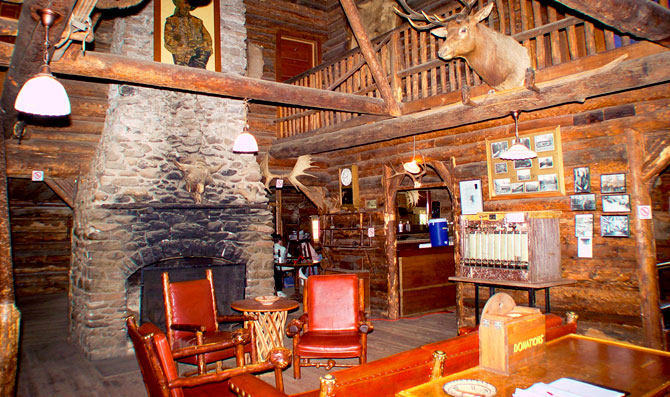
The architect of Pahaska Tepee Lodge was by A.A. Anderson, also thought of as the father of the Forest Service. The building’s two story hewn log construction is a study for architects and builders alike. All materials were requisitioned from the building site, which lies in the middle of the Shoshone National Forest on a special use permit. Hardware and glass were hauled from the Cody railhead by wagon on the newly constructed North Fork road which was built by volunteers in the Cody Auto Club and Wapiti Valley developers.
Buffalo Bill believed that once word got out about the incredible mountain scenery and abundant wildlife of the spectacular Wapiti Valley, the Cody road would soon become the most popular entrance to Yellowstone. In 1917, motorized vehicles were admitted to Yellowstone and Pahaska grew into a mountain village welcoming Park visitors as it still does today. By 1923, the East Entrance’s scenery and close proximity of roads to the East made it the busiest entrance to the Park.
Today the Old Lodge still stands in all of its glory. Walking in the front door of the lodge is like walking into another era. Every facet of the original building is preserved in every detail. The deep golden brown logs and the historic architecture of the two story structure come together for an experience right out of the heart of the old west. You can almost hear the stories and lore that have been spun in the building over the years.
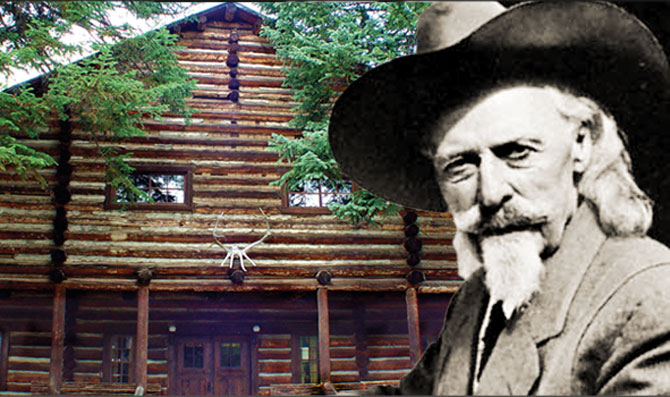
William Frederick Cody (1846-1917)
William F. "Buffalo Bill" Cody was born just west of the Mississippi River near LeClaire, Iowa on February 26, 1846. At the age of 12, he worked for a wagon train going to Fort Laramie; one year later he participated in the gold rush to Colorado; at age 15, he rode for the Pony Express. By the end of his life, Buffalo Bill had come to symbolize the American frontier itself.
Cody served as a scout for the Union's 7th Kansas Cavalry during the last years of the Civil War. On March 6, 1866, Will married Louisa Frederici (1843-1921) in St. Louis. They had four children: Arta Lucille (1866-1904), Kit Carson (1870-1876), Orra Maude (1872-1883) and Irma Louise (1883-1918). In 1867, Cody began hunting buffalo for Kansas Pacific work crews, earning his moniker "Buffalo Bill" and his reputation as an expert shot. The next year, Cody was employed by the U.S. Army as a civilian scout and guide for the Fifth Cavalry. His experience and skills as a plainsman made him an invaluable tracker and fighter. In 1872, Cody became one of only four civilian scouts to be awarded the Congressional Medal of Honor during the Indian Wars for valor in action.
General Phillip Sheridan saw in Cody a combination of charisma and frontier know-how - a natural public relations windfall for the Army of the West, which was in need of some good publicity. Under the protection of the Army, visiting dignitaries - such as the Grand Duke Alexis of Russia - took lavish hunting expeditions with Buffalo Bill as their guide and accompanied by General Sheridan and Brevet Major General George Armstrong Custer. These excursions were full-scale media events, glamorizing both the military and Cody.
The pulp industry romanticized the exploits of the heroes and villains who roamed the plains, and Buffalo Bill was a central figure of these inflated truths. In 1872, Cody was persuaded by dime novel writer Ned Buntline to take to the stage, portraying himself. The show business bug hit, and led to the formation of Cody's own "combination" troupe in 1873. The group included James Butler "Wild Bill" Hickok and Texas Jack Omohundro - being authentic Western characters they gave some credence to the melodrama.
During the height of the Plains Indians resistance to white settlement, Cody returned to the prairies in the summer to scout for the Fifth Army. On July 17, 1876, just three weeks after Custer and the Seventh Cavalry were defeated at Little Big Horn, Cody's regiment intercepted a band of Cheyenne warriors. When Buffalo Bill, in his stage clothing, killed and scalped a Cheyenne warrior named Yellow Hair (often mis-translated as "Yellow Hand"), he reportedly cried out "First scalp for Custer!" Buffalo Bill the frontiersman had proven that Buffalo Bill the character was no mere actor.
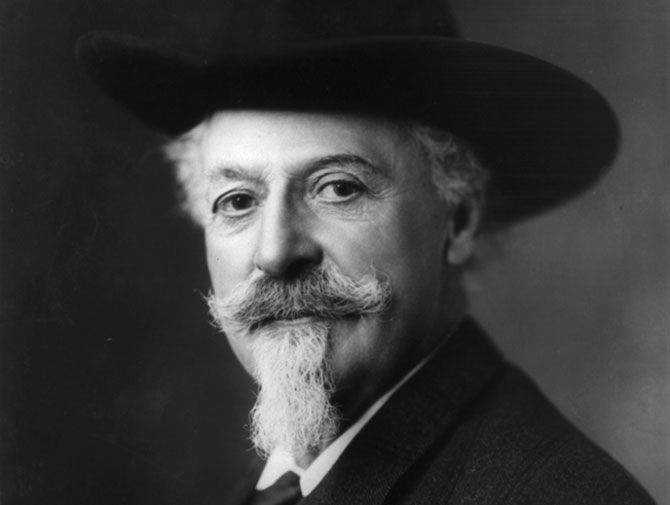 Public domain photo via the Library of Congress
Public domain photo via the Library of CongressNature's Nobleman
In 1883, Cody created what would become Buffalo Bill's Wild West, a vehicle that propelled him to fortune and worldwide fame. The Wild West would run - in one form or another- for 30 years, charming crowds throughout the United States and Europe. In Europe, Cody was called "Nature's Nobleman" because he was someone who had grown up on the frontier yet represented all of those best aspects of civilization.
Despite his characterization as a figure from the past, Buffalo Bill always looked to the future. As a businessman, he invested in projects that he hoped might bring economic growth to the West. With his earnings he invested in an Arizona mine, hotels in Sheridan and Cody, Wyoming, stock breeding, ranching, coal and oil development, film making, town building, tourism, and publishing. In 1899, he established his own newspaper, the Cody Enterprise, which is still the main source of information for the town of Cody today. Taking advantage of his celebrity status, Cody was an early advocate of women's suffrage and the just treatment of American Indians.
By the turn of the 20th century, William F. Cody was probably the most famous American in the world. No one symbolized the West for Americans and Europeans better than Buffalo Bill. He was consulted on Western matters by every American president from Ulysses S. Grant to Woodrow Wilson. He counted among his friends such artists and writers as Frederic Remington and Mark Twain. He was honored by royalty, praised by military leaders, and feted by business tycoons. Cody was America's ideal man: a courtly, chivalrous, self-made fellow who could shoot a gun and charm a crowd. Yet as Annie Oakley put it - he was the simplest of men, as comfortable with cowboys as with kings.
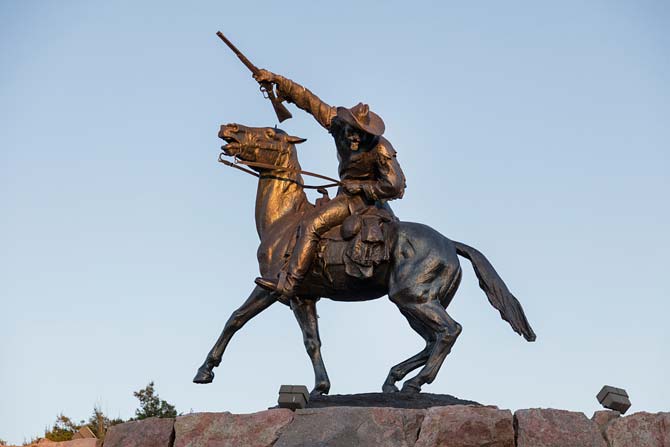 Public domain photo via the Library of Congress
Public domain photo via the Library of CongressBuffalo Bill's Autobiography
His Story shows his Devotion to Duty as a Child when Supporting his Widowed Mother, his Valuable Services to the Government while riding in the Famous "Pony Express" and Vividly Portrays his Thrilling Experiences as Hunter and Scout while acting as Guide to the Army and Trains of Prairie Schooners -- His many Hair-breadth Escapes and Fights with Indians, Desperadoes and while Hunting Buffalo and other Wild Animals, as well as his Later Triumphs in Conducting the Tours of his Great Wild West Exhibition in the United States and Europe. The whole work comprising an Authentic History of many Events inseparably interwoven with the Exploration, Settlement and Development of our Great Western Plains. – 1917
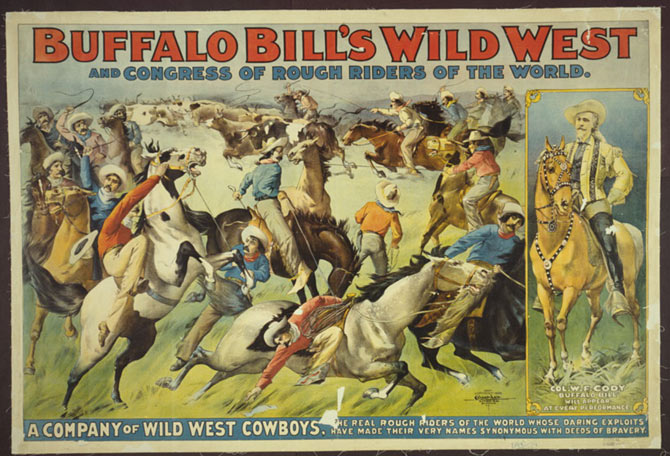 Original copyright by Courier Litho, Co., Buffalo, N.Y. via the Library of Congress
Original copyright by Courier Litho, Co., Buffalo, N.Y. via the Library of Congress